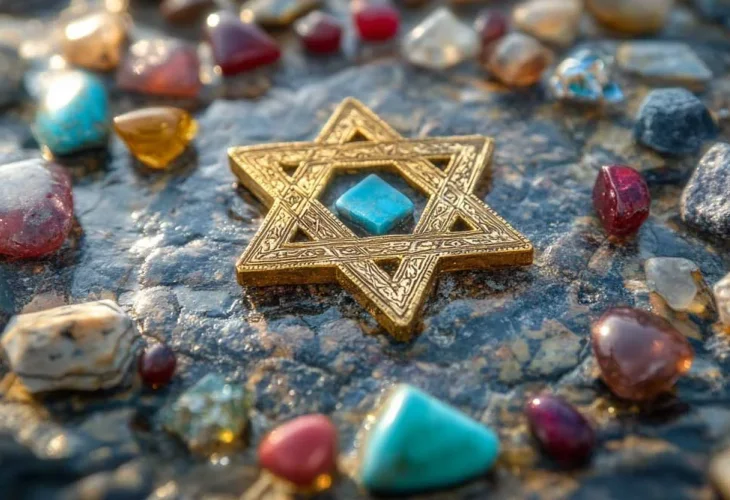For the Woman
The Hidden Meaning of Gemstones in Judaism: From the High Priest’s Breastplate to Modern Jewelry
Discover the spiritual symbolism behind the twelve stones of the Choshen, their connection to the tribes of Israel, and how these ancient gems continue to inspire beauty and faith today

For generations, different civilizations have ascribed deep meaning to precious stones — some for their beauty, some for their supposed powers, and others for their spiritual symbolism. Judaism, too, recognizes the significance of gemstones, beginning with those set in the breastplate (Choshen) of the High Priest, continuing through various Jewish symbols and traditions across the ages.
What do we actually know about the colorful gemstones sold today? Are they the same stones mentioned in the Bible?

The Breastplate of the High Priest
The Choshen was one of the eight garments worn by the High Priest in the Temple. It was adorned with twelve precious stones, each representing one of the twelve tribes of Israel. Upon each gem, the name of its corresponding tribe was engraved.
Rabbeinu Bachya, in his commentary on Parshat Tetzaveh (Shemot 28), wrote: “Know that it is written in the books of natural wisdom that all primary and foundational precious stones number twelve, and they are the progenitors of all others.”

The twelve stones mentioned in the Torah were:
Ruby – Reuven
Prase – Shimon
Carbuncle – Levi
Emerald – Yehuda
Sapphire – Issachar
Pearl – Zevulun
Leshem – Dan
Turquoise – Naphtali
Crystal – Gad
Chrysolite – Asher
Onyx – Yosef (Ephraim and Manashe)
Jasper – Binyamin
Scholars still debate whether these are the same stones we identify by those names today.

The Mystery of the Topaz
One of the most famous gemstones is the topaz, whose color ranges from golden-yellow to transparent, sometimes with hints of blue or pink. Across cultures, topaz has symbolized wisdom, loyalty, and calm.
Some researchers believe that the Prase mentioned in the Torah — associated with the tribe of Shimon, may in fact be the same as the modern topaz.
The Turquoise: A Stone of Protection
The turquoise, known for its striking blue-green color, has long been seen as a symbol of protection and good fortune — both in world cultures and in Jewish tradition.
In many Jewish communities, turquoise was believed to ward off negative energy and the evil eye. It was often set into amulets, jewelry, and protective symbols, such as the Star of David (Magen David) and the Hamsa.

The Ruby: Symbol of Courage and Life
The ruby, or Odem, is among the most valuable and dazzling gemstones in the world. In some cultures, it symbolizes courage, passion, and vitality.
In Jewish tradition, the Odem is associated with the tribe of Reuven — though it is uncertain whether this ruby is the same stone mentioned in the Torah.

What Makes a Gem Precious?
A stone is considered “precious” when several factors combine:
Rarity: The rarer a stone is in nature, the more valuable it becomes — as seen with diamonds, rubies, and sapphires.
Beauty: Color, clarity, and luster greatly influence a gem’s worth. Stones that reflect light uniquely or have striking hues are especially prized.

Durability: Hardness, measured on the Mohs scale, affects value. Durable stones like diamonds and sapphires are long-lasting and desirable.
Cultural and Spiritual Meaning: In some cases, a gem’s significance in religion or tradition adds to its worth.
Cut and Polish: Expert craftsmanship can reveal a stone’s inner brilliance and enhance its natural beauty.
Market Demand: Modern jewelry trends also affect gemstone prices and popularity.

Eternal Beauty and Spiritual Symbolism
Throughout history, precious stones have adorned jewelry, royal crowns, and sacred objects — and they remain beloved today. Designers continue to incorporate colorful gems into creative, contemporary pieces.
The turquoise, for instance, remains especially popular as both a decorative and symbolic stone, often appearing in modern Jewish jewelry.

Perhaps one day soon, as tradition teaches, we will once again witness the dazzling beauty of these twelve stones shining on the breastplate of the High Priest in the rebuilt Temple — speedily in our days, Amen.

